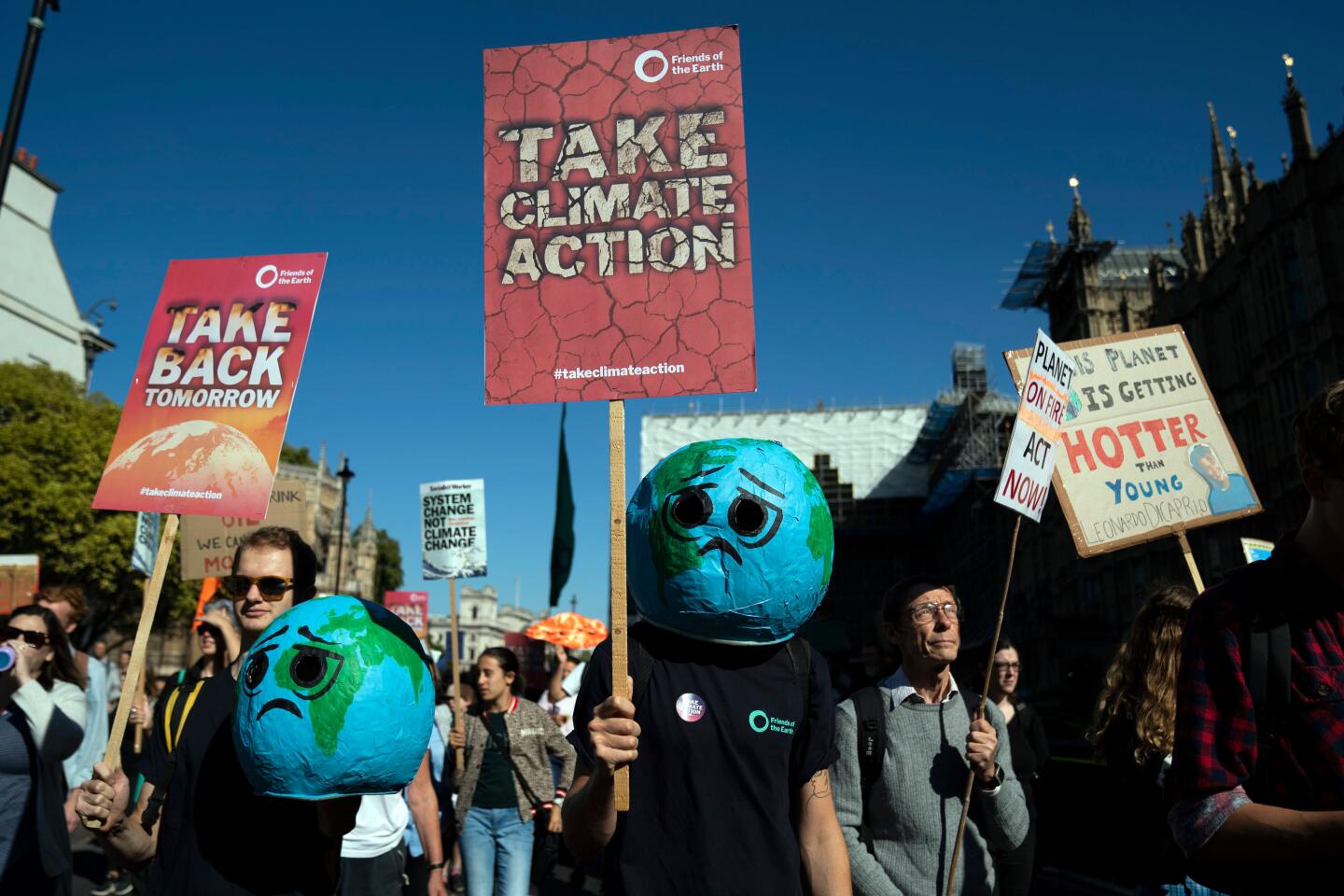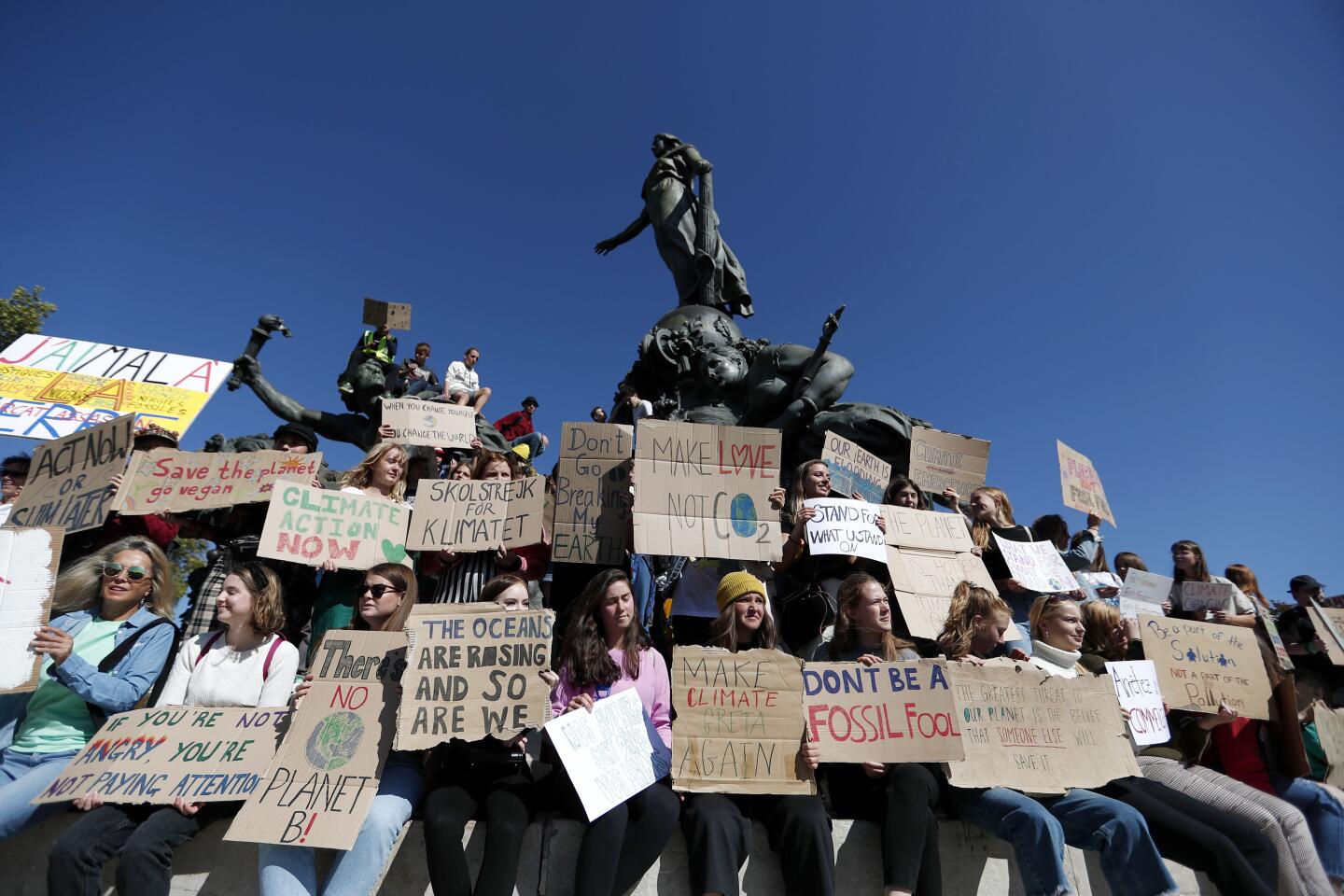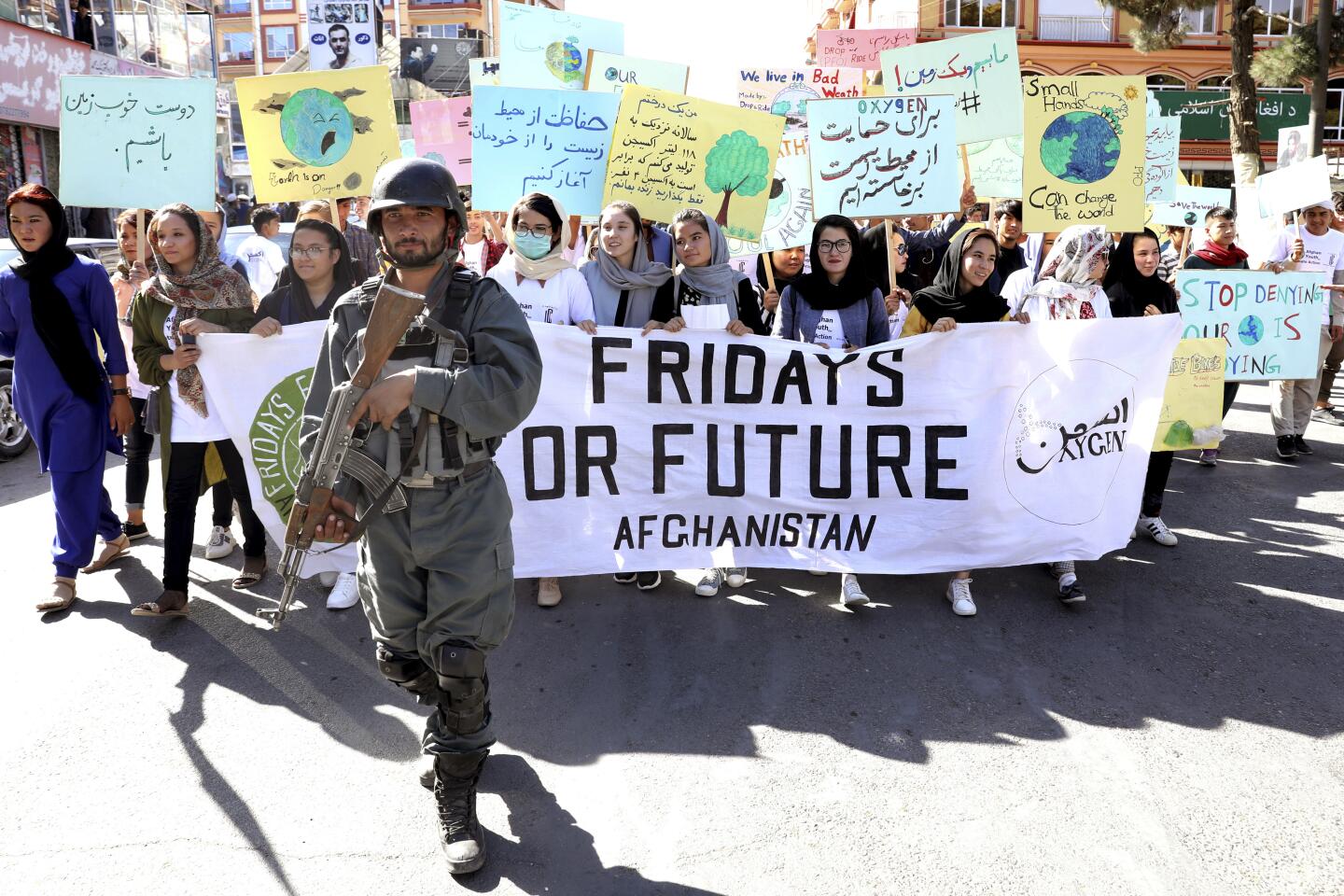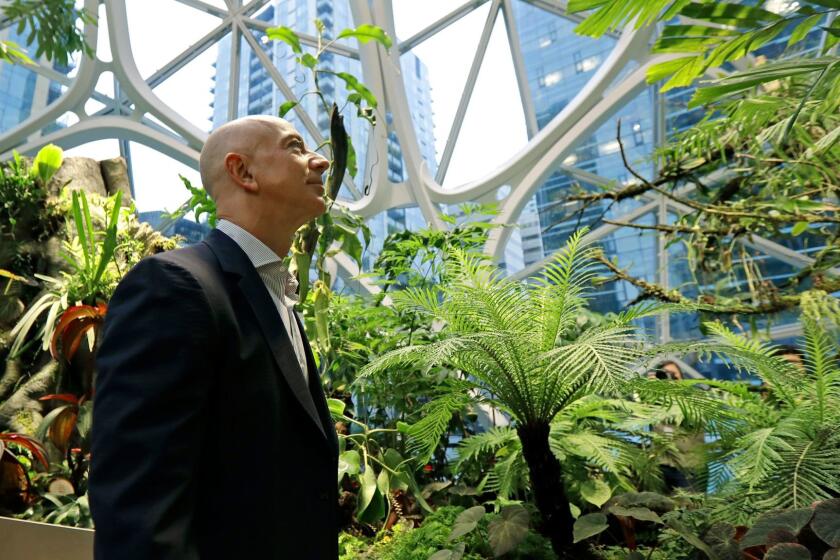What’s behind the youth movement to tackle climate change? Fear — but also hope
- Share via
Ella Shriner doesn’t remember learning about climate change. It was always just there — a somber backdrop to her young life.
But the older she got, the more pressing the issue seemed.
“It’s something affecting people, not just the polar bears,” said the high school senior from Portland, Ore. “In my lifetime, for sure, it’s going to affect everyone personally.”
So Ella became an activist. In 2016, she campaigned for a measure that successfully banned the construction of new fossil-fuel storage facilities and export terminals in her hometown. She also joined the Portland Youth Climate Council and is fighting to save old trees growing on land zoned for industrial use.
Recently, she’s helped organize the global climate strike, which will take place in cities around the world Friday, just days before the United Nations Climate Action Summit in New York.
On a recent Sunday morning, Ella and a dozen other young activists met at the local Sierra Club office and ticked through the items on their agenda, including deciding what time students should walk out of class and which route to march from Portland City Hall to the Oregon Museum of Science and Industry, where they plan to hold a rally.
Walkouts are taking place worldwide Friday calling for action on climate change in a youth-led movement for renewable energy and carbon-neutral goals.
When the question of street permits came up, Ella agreed that it would be safer to secure them. But she had philosophical reservations.
“We are trying to be a little bit rebellious — saying this is not working for us,” she said to her compatriots seated around a large wooden table. “And we need it to work for us.”
Ella’s statement captures the zeitgeist behind the growing wave of youth climate activism: that the reigning economic order imperils young people’s future by putting profits ahead of the planet.
The movement has taken off over the last year, led by teenagers like Greta Thunberg, the 16-year-old from Sweden who testified before Congress on Wednesday, imploring lawmakers to heed scientists’ warnings about climate change. By organizing school walkouts, public protests and social media campaigns, young people have drawn the world’s attention to global warming in ways that decades of studies could not.
Underneath the activism lies a simple truth: Young people are incredibly scared about climate change. They see it as a profound injustice and an existential threat to their generation and those that will follow.
“It’s hard to not feel hopeless because it feels inevitable,” said 16-year-old Lana Perice after the planning meeting in Portland wrapped up.
On Friday, 5,000 youth-led demonstrations in 156 countries — 100-plus in California — will demand government action to end reliance on fossil fuels.
Youth are struggling to cope however they can. But they are not giving up.
“Even with this inevitability, I feel proud knowing that my generation isn’t going down without a fight,” Lana said.
::
Like all people, kids have a range of perspectives on climate change. A small percentage — mostly made up of boys — doesn’t sweat it much. But research shows that many members of Generation Z are deeply concerned.
“They do worry, and they worry kind of a lot,” said Maria Ojala, an environmental psychologist at Orebro University in Sweden.
And how could they not?
On top of the usual adolescent pressures — grades, social hierarchies and budding romances — young people are confronting a world that may be unrecognizable by the time they grow up.
Arielle Martinez Cohen remembers reading a report from an Australian think tank that warned the human species could face extinction by 2050 if society doesn’t get its act together.
“That gives me chills and scares the heck out of me,” said Arielle, an 18-year-old from Los Angeles and an activist with the youth climate group Zero Hour. “I go to bed thinking about it.”
Even if that doesn’t happen, she worries about the collapse of agriculture, food shortages and rising lawlessness as people vie for increasingly scarce resources.
Her fears are hardly unfounded. Scientists have determined that climate change already threatens crop production and probably contributes to violent conflict and migration.
“I almost imagine, like, an apocalypse-type thing happening,” Arielle said.
Many young people say they can’t fathom bringing kids of their own into the world.
“It’s not ethical. It’s literally a burning house,” Lana said.
“That’s something that’s not realistic,” agreed her twin sister, Yena.
The U.N. Climate Change Summit will kick off next week in New York. What is it, and what do its organizers hope to accomplish?
And how can they even think about college or contemplate their careers when faced with so much uncertainty?
“It’s something I feel every single day,” Yena said. “I work really hard at school and I do all these things, and I’m like, ‘What am I working for? Do I have a future?’”
Teens don’t have to imagine all of the troubling consequences of climate change. Some are already here.
Around the country, classes and sports have been canceled because of intense heat and dangerous levels of wildfire smoke.
Over the summer, 13-year-old Jacob Brown had to stop fishing at Rosedale Lake, a favorite spot near his home in Hopewell, N.J., because toxic algae had turned the water a soupy green.
“It has to do with the amount of rain we are getting,” said the middle schooler, who recently attended a climate change academy at a nearby nonprofit called the Watershed Institute. (Indeed, New Jersey has seen a rash of harmful blooms caused by warmer temperatures and increasingly extreme rainfall events that flush nutrients from nearby farms into rivers and lakes.)
Stella Reeves, a 12-year-old from Grass Valley, Calif., jokes that there are only two seasons in California now: allergy season and fire season. Last year, she watched flames tear through the town of Paradise, 50 miles away, and worried that her community could be next.
“It was very scary just knowing that we may have to evacuate,” Stella said.
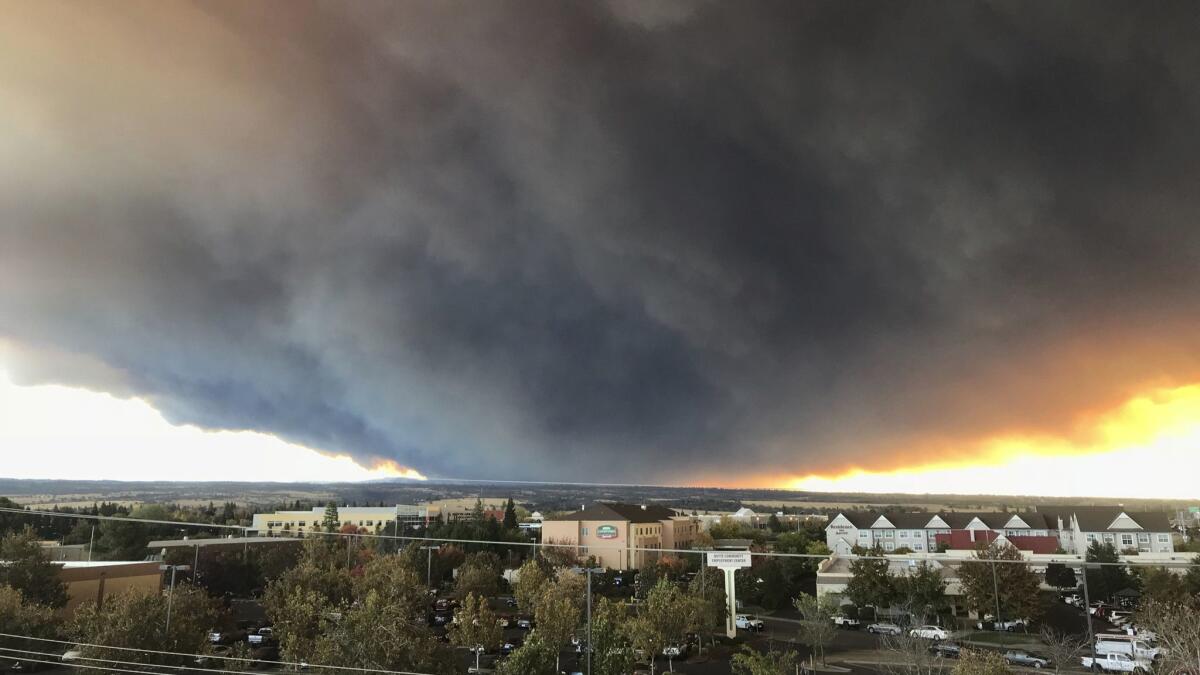
It’s even harder knowing that others have it worse, she said. In July, Stella participated in a climate change camp and learned that people around the world are dying in natural disasters, like flash floods in South America.
“The heavy stuff is how we’re losing lives, and things are happening now because of climate change,” Stella explained matter-of-factly, blinking behind her purple glasses. “At some points, it can even get you crying.”
::
All of this can tempt young people to despair. But somehow, they remain hopeful.
Ojala studies how kids cope with climate change, and she sees a number of strategies. Some distance and distract themselves; others focus on trying to solve the problem.
Her surveys of Swedish youth suggest that kids fare best when they engage in what she calls meaning-focused coping, which emphasizes finding sources of hope and support rather than getting rid of worry. Some young people recognize that, while climate change is serious, humanity has solved difficult problems before. They can also force themselves to adopt a kind of defiant optimism.
But one of the most effective forms of meaning-focused coping, Ojala said, is to place trust in others, be they scientists, environmental groups or politicians. The key is for young people to “see that the grown-up world is also doing something,” she said.
Ojala’s results square with research by social scientist Kathryn Stevenson of North Carolina State University, who has found that kids feel more hopeful when they think that people are willing to act, and that those actions matter. That’s why it’s important for schools to teach kids not only about climate change, but what society can do about it, she said.
Amazon workers have spent this year urging CEO Jeff Bezos take more urgent steps on climate change. They’re a key reason Amazon’s environmental footprint is under scrutiny.
Learning about solutions made all the difference for Shamar Tilghman, of Trenton, N.J., who attended the Watershed Institute’s Climate Change Academy in 2018.
“They sat us down and told us everything bad. It was, like, very heartbreaking,” said Shamar, who is now a senior in high school. “What really helped me is learning all the ways that we can fix it.”
In particular, he said, he was excited to learn about hydrogen fuel cells that produce power for cars and buildings without burning fossil fuels and green architecture techniques that save energy and water.
Stella also finds inspiration in electric cars and other sustainable technologies that will help address climate change.
“It’s going to take a little while, but I’m sure that there will be a way,” she said.
Others said they are encouraged by proposals like the Green New Deal, championed by politicians such as Rep. Alexandria Ocasio-Cortez (D-N.Y.), and by legal efforts, such as the lawsuit brought by 21 young Americans that accuses the federal government of violating their right to a safe and livable climate.
The surge of youth activism is itself a source of hope.
“I think it will actually work this time in creating some change,” said Arielle, the 18-year-old Angeleno.
::
On Friday, young people will take to the streets in thousands of cities from Alaska to Indonesia to call for aggressive action on climate change. They hope adults will join them, but their relationship with grown-ups is fraught.
On the one hand, they’re angry that society hasn’t dealt with the problem already.
“The youth have been failed,” said Lana.
On the other hand, kids recognize that they can’t tackle climate change alone, and they’re sick of hearing that their generation will save the day.
“Adults are the ones who can really take charge right now,” Shamar said. If the world has to wait until kids grow up to act, he said, “it may be too late.”

But teens are still waiting for a sign that their elders get it.
“A lot of people kind of have their heads in the sand about it,” said Jasmine Wu, a high school junior from Troy, Mich.
Jasmine, who is contemplating a career in environmental science, said she doesn’t understand that response.
“I’ve always felt that if you are afraid of something, you should probably just meet it head-on,” she said.
“Hiding from something that scares you is probably the worst way to handle it. Especially if it’s something that you can help prevent.”






